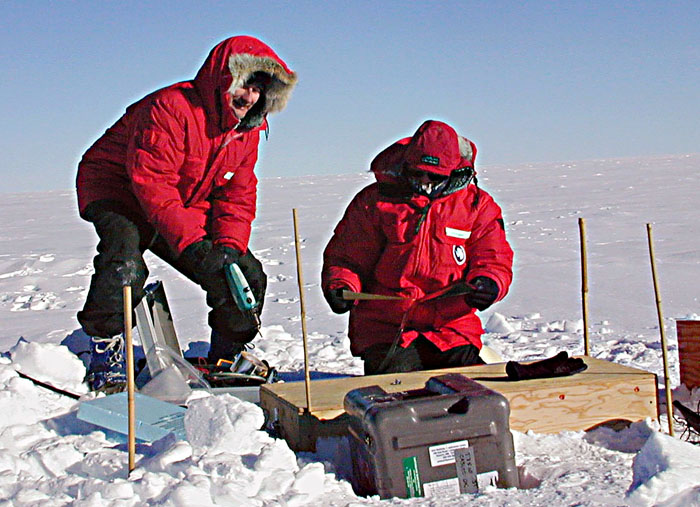|
Earthshaking discoveryResearchers find Antarctic ice streams release seismic waves equal to magnitude 7 earthquakePosted June 27, 2008
Antarctic scientists reported something of an earthshaking discovery in the June 5 issue of the journal Nature. Douglas Wiens, a professor of earth and planetary sciences at Washington University in St. Louis Although this study was restricted to a single ice stream, the new findings document behavior that runs counter to how scientists generally have perceived glacial motion, according to Wiens. “Glaciologists model the flow of glaciers using the assumption that it’s basically a kind of creeping … motion. But recently we’ve been seeing seismic signals coming from a number of ice streams and glaciers, and no one’s been able to interpret them,” said Wiens, who led the research team. Sridhar Anandakrishnan, one of the Penn State University Seismologists use the Richter magnitude scale to measure the amount of seismic energy released by an earthquake. An earthquake measured at between 7.0 and 7.9 on the scale is considered “major.” For comparison, the earthquake that struck central China and killed an estimated 70,000 people on May 12, 2008, reached at least 7.9 on the Richter scale. Using an array of 19 GPS sensors and seismic sensors, deployed as part of the National Science Foundation-funded TransAntarctic Mountains Seismic Experiment (TAMSEIS) The data show that the river of ice moves about a half-meter within ten minutes, remains still for 12 hours, then moves another half-meter. Each time it moves, it emits seismic waves that are recorded at seismographs around Antarctica, and even as far away as Australia, a distance of more than 6,400 kilometers. Seismic waves from “glacial earthquakes,” mainly near Greenland, were originally reported in 2003, and the numbers have been increasing in recent years, according to the researchers. Some scientists think the seismic waves occur as chunks of ice calve off a glacier and float away, a very violent activity that could generate strong seismic signals. The new results show that at least some of the glacial earthquakes are produced by this stick-slip phenomenon. “At first we didn’t know where the waves were coming from; but eventually we were able to narrow down the source to the ice stream,” Wiens said. “This stick-slip phenomenon may provide a clue about what makes these ice streams move faster or slower,” he added. Part of the mystery may be located below the ice. Scientists believe subglacial hydrology, the waterworks underneath the ice sheets that remains largely unmapped and unknown, may help lubricate the ice and speed glacial movement. “A big puzzle is why this particular ice stream shows this slip-stick behavior and others don’t, and we don’t really understand why,” Wiens said. “Our results show that the stick-slip motion originates from a sticky region on the bed of the ice stream where friction is higher, perhaps due to the absence of water. Also, we know that this ice stream is slowing down. Perhaps the sticky spot is responsible for both phenomena.” Added Anandakrishnan, “What is apparent from these results is that the conditions beneath the glaciers and ice streams are critically important in the flow of those masses of ice. Without a better understanding of the subglacial environment, our ability to model and predict future behavior of ice sheets and sea level will be hampered.” Wiens said he plans to study seismic records of stick-slip events going back several decades to see if there are changes, and also to search for similar signals from other ice streams. “We need to understand what controls the speed of the ice streams, because that will affect how fast the ice in Antarctica will go away and sea level will rise, as global warming melts the West Antarctic ice sheet.” NSF-funded research in this story: Doug Wiens, Washington University in St. Louis; and Sridhar Anandakrishnan, Penn State University.
|



For USAP Participants |
For The Public |
For Researchers and EducatorsContact UsU.S. National Science FoundationOffice of Polar Programs Geosciences Directorate 2415 Eisenhower Avenue, Suite W7100 Alexandria, VA 22314 Sign up for the NSF Office of Polar Programs newsletter and events. Feedback Form |


